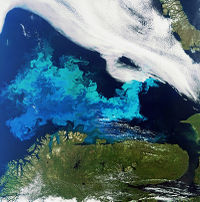Difference between revisions of "Portal:Eutrophication"
From Coastal Wiki
| Line 22: | Line 22: | ||
| − | {{/box-header|Did you know?|{{FULLPAGENAME}}/ | + | {{/box-header|Did you know?|{{FULLPAGENAME}}/Eutrophication|}} |
| − | {{{{FULLPAGENAME}}/ | + | {{{{FULLPAGENAME}}/Eutrophication}} |
{{/box-footer|[[{{FULLPAGENAME}}/Did you know/archive|Archive]] – [[Help:Starting a new page|Start a new article]]}} | {{/box-footer|[[{{FULLPAGENAME}}/Did you know/archive|Archive]] – [[Help:Starting a new page|Start a new article]]}} | ||
| − | {{/box-header| | + | {{/box-header|Remote Sensing|{{FULLPAGENAME}}/Remote Sensing|}} |
{{/Categories}} | {{/Categories}} | ||
{{/box-footer|}} | {{/box-footer|}} | ||
Revision as of 14:41, 30 March 2012
edit
Eutrophication
Eutrophication ('eu' = true or well; 'trophy' = food) is a leading threat to water quality around the world. In the North Sea and English Channel, the phenomenon is related to two major activities: agriculture and industry. This gives an excess of nutrients (nitrates, phosphates,...) in the water. This enrichment promotes the growth of algae. A small increase in algal biomass does not have any adverse effect on the ecosystem and can even result in an increase in certain fish populations. An over-stimulation of the growth of algae (an algal bloom), however, can lead to turbidity of the water. When the algae die, the water may be temporarily low in oxygen (hypoxia) what can result in the death of many fish.
edit
Did you know?
European legislations regarding eutrophication
Eutrophication causes and consequences
Monitoring
Modelling
Eutrophication in the news
Dictionary
edit
Remote Sensing
edit
Topics
What are Portals? | List of portals
